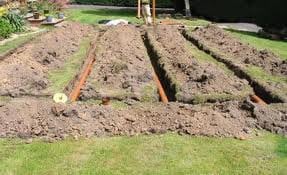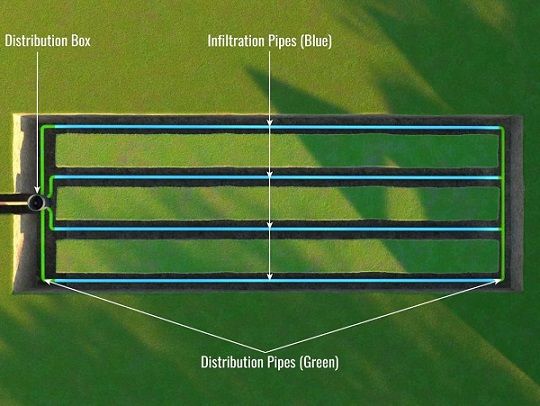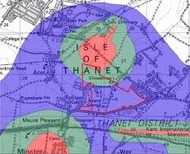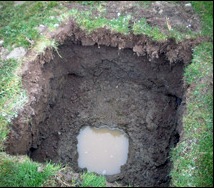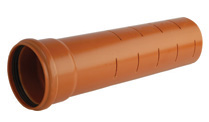Regulations for Sewage Effluent Drainage Fields
Soakaway Regulations have changed. It is no longer acceptable for a soakaway to be used. A Soakaway is only allowed for the dispersal of rainwater from the gutters and yard drains.
All effluent from septic tanks and sewage treatment plants must be 'soaked away' in a properly designed and installed Drainage Field. This drainage field and associated pipewark must be signed off by a Building Inspector, as all sewage works are now covered by Building Control at your Local Council, under Section H2 of the Building Regulations.
The Soakaway Drainage Field design must also be in accordance with the British Standard BS 6297:2007 + A1 2008.
The above rules cover any soakaway drainage field that was installed since January 2000, when Section H2 was created. If your discharge to the ground was before this date, then you still have to comply with the General Binding Rules, or get a Permit for the discharge from the Environment Agency.
The maximum amount of discharge per day to a soakaway drainage field is 2000 litres - 13 person's worth.
Soakaways versus Soakaway Drainage Fields
A Soakaway is a hole in the ground, traditionally, filled with rubble, stones or bricks. The idea is that the voids between the rubble create a storage space for the liquid, which then soaks away during dry periods. More recently, crates have been developed, as they provid a larger void volume, but they are illegal for sewage effluent and are for rainwater only
Although they are now illegal for sewage effluent, it is amazing how many 'Cowboy' installers still install them.
The reasons that soakaways are not allowed are as follows:
- It does not rain every day. Soakaway pits fill up when it rains and drain when it is not raining, but sewage effluent discharges EVERY day, with no dry days to allow the pit to drain. The pit becomes full and the sewage either 'backs-up' the pipes or bursts through the surface of the ground.
It is not a serious matter if rainwater bubbles to the surface of the ‘pit’ during extreme weather, but sewage effluent surface contamination is an entirely different scenario. Please visit Sewage Problems if you have soakaway issues with your current system. Also visit Failed soakaway drainfield insurance claims.
- The Building Regulations and BS 6297 2007 state that the sewage effluent MUST be in constant contact with the AEROBIC particles of the soil. As the aerobic soil layer ends at 1 metre below ground, soakaway pits are not allowed.
- Soakaways bypass the aerobic soil layer and thereofre do not allow any aerobic treatment of the sewage effluent. This causes groundwater pollution because sewage effluent, even from a sewage treatment plant, still contains bacteria and viruses. These must be digested by the aerobic natural soil bacteria, which cannot live lower than 1 metre below ground, as there is no air there.
There are 3 tests that you MUST undertake to determine whether or not you are allowed to construct or replace a sewage soakaway drainage field at all, done in this order: They are all mandatory under Building Regulations.
Test 1 - The Environment Agency Test For Soakaway Drainage Field Contamination Issues
Ascertain whether or not your soakaway drainage field site is in an area designated by the Environment Agency as a Groundwater Source Protection Zone 1.
If it is, then it means that the groundwater underneath your soakaway is abstracted via a borehole somewhere and used for drinking water You will not be allowed to pollute it with sewage effluent bacteria and viruses from a septic tank or sewage treatment plant soakaway drainage field and will not be allowed to have one.
Contact us and we will be able to determine this on the phone.
Test 2 - The Trial Site Assessment Hole For Groundwater Levels
The Trial Site Assessment Hole (TSAH) This is a single, large hole which is a minimum 2 metres deep and 1 metre square. It is to determine that the water table, or bedrock, NEVER reaches to within 1.5M of the bottom of the soakaway drainage field pipe. Many sites in the UK fail this vital test and many builders and tank installers never carry one out - until it is too late. If this test fails, then it is pointless doing any percolation tests if you are thinking of installing an underground drainage field, as your site has already failed. We can, however, design an above ground soakaway drainage mound (Copyright WTE Ltd.) for you if you have enough land and no other alternative.
Test 3 - The Percolation Tests For Soakaway Drainage Field Soil Porosity
The Percolation Tests are done to test the porosity of the soil. If the water soaks away either too fast or too slowly, then a soakaway drainage field is not permitted. In general, clay soils will fail miserably, and it is not worth performing the tests. This is the test that most people associate with soakaway tests, as it has been mandatory for much longer that the TSAH. The Percolation Test tests the porosity of the soil immediately below and surrounding the 300mm. of drainage stone in the trench below the pipe.
Percolation Tests CANNOT be performed at more than 1 metre deep to the bottom of the percolation test hole. This is clearly stated in the Building Regulations and the BS6297 2007 as the maximum depth allowed for soakaway pipework is 700mm, with 300mm. of washed drainage stone below this in the trench. It is amazing how many surveyors do these tests too deep and they are then invalid.
Our above ground mound soakaway design (Copyright WTE Ltd. 1996) can solve the problems of clay soil percolation failures.
Regulations For The Design And Materials To Be Used For A Soakaway Drainage Field
Minimum soakaway drainage field distances
ALL parts of the soakaway drainage field are required to be a minimum of:
- 10m from a watercourse or ditch.
- 50m from water abstraction points, boreholes, springs.
- 15m from any building, and sufficiently distant from any other soakaway, including roof water.
- 2 metres from a boundary.
Other Drainage Field Regulations
- The soakaway drainage field area should be downslope of groundwater sources.
- No water supply pipes or underground services should be within the soakaway drainage field area.
- No access roads, driveways or paved areas should be within the soakaway drainage field area. This includes fields with tractor and agricultural vehicular traffic.
- The water table or bedrock must not, at any time, be within 1 metre of the bottom of the soakaway drainage pipe itself. This usually means that it has to be a minimum of 2 metres below ground, at all times.
- The maximum depth allowed for soakaway drainage field pipework is 700mm.
- The maximum length of a single pipe-run is 30 metres.
- No rainwater must be allowed to enter the system.
Sizing of a Soakaway Drainage Field - length of drains
The length of the soakaway drainage field drains is determined by the number of bedrooms in the house and the porosity of the soil. The new regulations state that for any house up to and including 3 bedrooms, the minimum size sewage system that can be installed is for 5 persons, with one extra person added for each extra bedroom. A 3 bedroom house requires a 5 person plant, a 4 bedroom house a 6 person plant, etc.
The porosity can only be determined by the percolation test, which measures the time it takes for water to drop 1mm. in the percolation test hole. From this time, known as a V value, the length of drain required can be calculated. It is impossible to know how many metres of drain you need without the percolation test results, so if anyone quotes for a drainage field without doing them, show them the door as they are a Cowboy.
Ask us for the Calculation Formula, once you have the V Value results.
WTE can calculate the length for you, if you are unable to do so yourself.
Construction of Soakaway Drainage Fields
- Pipes should be laid at a minimum depth of 200mm and a maximum depth of 700mm. to enable aerobic contact between the effluent and the drainage stone and soil particles.
- The Maximum length of a single trench is 30 metres.
- Pipes should be laid on 300mm of clean shingle, gravel or broken grade 1 stone ( 20mm – 50mm ).
- Soakaway drainage field trenches should be filled to a level of 50mm above the pipe and covered with a layer of geotextile membrane to prevent silt entry.
- The remainder of the soakaway trench can be filled with topsoil.
- Drainage trenches should be between 300mm and 900mm wide with areas of undisturbed ground of minimum 1m wide between parallel trenches.
- An inspection chamber should be installed between the septic tank and the drainage field.
- The soakaway drainage field layout should be set out as a continuous layout, fed from the inspection chamber, NOT a straight pipe run with an 'end', or a herringbone layout. It should looks like an Oven Shelf from a bird's eye view.
- The soakaway drainage pipes should be fed by a distribution chamber.
- The area of the soakaway drainage field is calculated after carrying out a minimum of three percolation tests in the proposed drainage field area, over three consecutive days and applying a formula as detailed on the Percolation Test page.
- Use SOLID perforated foul drainage pipe, with the slots/holes at the bottom, laid in trenches of a uniform gradient not steeper than 1:200. Perforated 'Flexicoil' land drainage pipe is NOT allowed nor are soakaway crates or tunnel systems. These are designed for SURFACE ROOF WATER ONLY.
Design of Soakaway Drainage Fields
Soakaway Drainage Fields are no longer herringbone in design. They now are a series of parallel drains surrounded by an outer connecting drain.
The drain from the sewage treatment plant or septic tank must enter a distribution box, prior to the soakaway drainage field. This box must be able to feed every connecting drain individually.
No leg of the drainage field can be more than 30 metres in length and the finished saokaway drainage field should resemble an oven shelf, from a bird's eye view.
The maximum depth that the drain itself can be laid is 700mm. to the bottom of the pipe from ground level. See below.
There must be a minimum of 1 metre between trenches.

